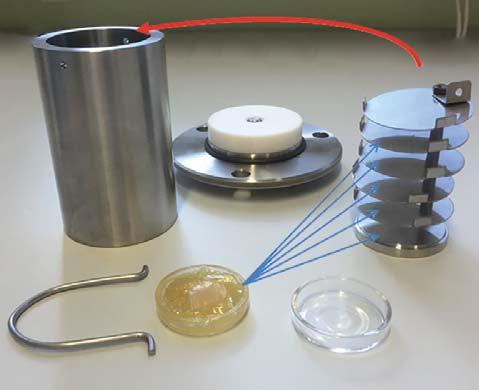
1 minute read
NEW! Determining the oxidative stability of lubricating greases
OELCHECK offers special analysis kits for the inspection of lubricating greases and implements for grease sampling (find out more in the Winter 2012 issue of OELCHECKER). An increasing number of lubricating greases are used for long-term or even lifetime lubrication. Grease manufacturers and OEM design engineers in particular should know the oxidative stability of the relevant greases in advance. After all, even long-term greases age. High temperatures and ambient oxygen above all cause the grease to oxidise.
It is not always possible to assess a fresh grease in a complex roller bearing test, for example the FE 8 with a test run with 10 bearings. Moreover, it is often dif ficult to find out comparable values, especially of lubricating greases sold outside of Germany.
To ensure that consistent information on oxidation-related relubrication intervals can be provided, from now on OELCHECK will also test the oxidative stability of lubricating greases. The test is conducted in accordance with the guidelines of ASTM D942 and serves, among other things, as a means of comparison and quality control of fresh greases.
For this test, RPVOT test equipment, which is used routinely to determine the oxidative stability of turbine oils, was fitted with an additional piece of apparatus in the OELCHECK laboratory for taking grease samples.
In the test, the lubricating grease is subjected to pure oxygen inside a hermetically sealed pressure chamber at an elevated temperature. The oxygen is consumed by the process of oxidation, which in turn lowers the pressure in the pressure chamber. Given that there are oxidation inhibitors in the lubricating grease, this drop in pressure can be prevented for as long as the additives can buffer the oxygen.
Ageing is simulated for a specified time (typically 100 or 200 h). The result is a drop in pressure during this period. The oxidative stability of the lubricating grease as a whole is determined, not just that of the separated base oil. The values that are ascertained from this process indicate the oxidative stability of the grease in its practical application. The longer it takes for the drop in pressure to register, the better equipped the grease is against premature ageing.
In five Petri dishes, each with a diameter of 40 mm, 4 g of grease are weighed out and spread evenly. Once they have been placed securely in a rack, the Petri dishes are put into the pressure chamber. After repeated injections of oxygen to pressurise the air, the pressure chamber is set to a pressure of 110 psi (approx. 7.5 bar) and a temperature of 99 °C. The pressure is then recorded continually for the duration of the test.





